다운 증후군(몽고증), Down syndrome
정상 남성 염색체 사진
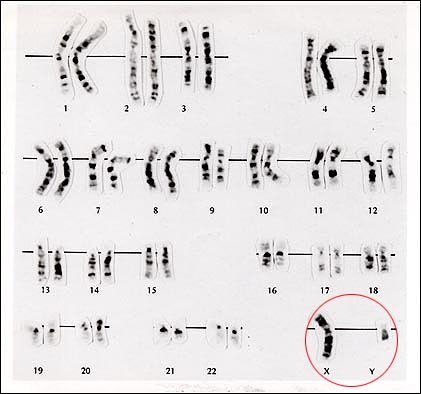
그림 1-221. 정상 남성 염색체
1-22번 염색체는 상염색체에 속하고 X Y 염색체(◯내)는 남성을 결정하는 성염색체라고 한다.
Dr. and Professor, Robert Greenstein, University of Conn Medical School.제공
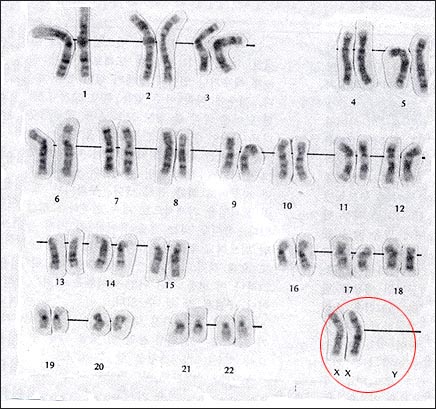
그림 1-222. 정상 여성 염색체
1-22번의 염색체는 상염색체에 속하고 X X 염색체(◯내)는 여성을 결정하는 성염색체이다.
Dr. and Professor, Robert Greenstein, University of Conn Medical School 제공
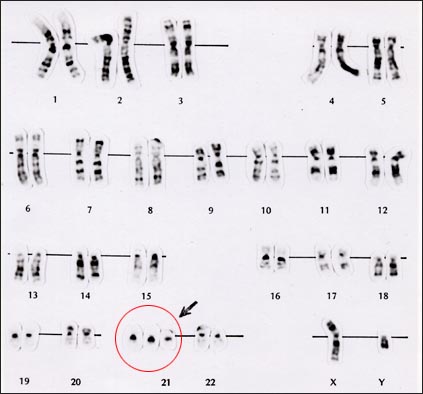
그림 1-223. 다운 증후군을 가진 남아의 염색체.
상염색체의 22번에 2개의 상염색체가 있는 대신 3개의 상염색체가 있어 트라이소미 21 증후군(다운 증후군)이 생긴다.
Courtesy, Dr. and Professor, Robert Greenstein, University of Conn Medical School 제공
다운 증후군(몽고증)의 원인
- 사람 염색체에 이상이 생기면 여러 가지 증후군이 생긴다. 그 중 가장 흔한 증후군이 다운 증후군이다.
- 사람의 염색체는 상염색체와 성염색체 두 종류 나눈다.
- 정상 사람의 총 염색체 수는 46개이다.
- 46개 중 44개는 상염색체이고 2개는 성염색체이다.
- 상염색체 수나 성염색체 수가 정상 수보다 1개 적거나 더 많거나, 염색체의 길이가 더 짧거나 더 길 수 있고, 염색체가 비정상적으로 생길 수도 있다.
- 염색체 이상이 있는 사람들에게 지능저하, 성장 및 발육 부진, 신체기형 등이 생길 수 있고, 정신적·육체적 이상이 생길 수 있다.
다운 증후군(몽고증)의 종류
① 표준형 다운 증후군
② 전좌형 다운 증후군
③ 모자이크형 다운 증후군
④ 부분형 다운 증후군 등이 있다.
- 다운 증후군을 몽고증, 트라이소미 21 증후군(21 trisomy syndrome)이라고도 한다.
- 다운 증후군 중 표준형 다운 증후군은 제 21번 상염색체의 수가 정상 수보다 하나 더 있다.
- 표준형 다운 증후군의 총 염색체 수는 47개이다. 제 21번 상염색체의 수가 가외로 1개 더 있으므로 생긴 표준형 다운 증후군 아이의 정신적·육체적 모든 면이 비정상적이다.
- 이런 종류의 염색체 이상으로 생긴 유전병을 표준형 다운 증후군, 몽고증, 21번 상염색체 3체성 다운 증후군, 또는 트라이소미 21 증후군(21 trisomy syndrome)이라 한다.
- 다운 증후군의 95%는 표준형 다운 증후군이다.
- 표준형 다운 증후군 말고 전좌형 다운 증후군(Translocation Down syndrome)이 있다. 전좌형 다운 증후군의 총 염색체 수는 정상 사람들의 총 염색체의 수와 같고 C 그룹의 염색체의 21번과 다른 그룹의 21번 간 전좌가 생길 수 있고, 14번 상염색체와 21번 상염색체 간 전좌가 생겨 전좌형 다운 증후군이 생길 수 있다.
- 다시 설명하면 전좌형 다운 증후군의 총 염색체 수는 46개이다.
모자이크형 다운 증후군
- 모자이크형 다운 증후군의 총 염색체 수는 46개일 수도 있고 47개 일 수 있다.
- 모자이크형 다운 증후군은 총 다운증후군의 4%를 차지한다.
- 가외로 상염색체가 하나 더 있는 모자이크형 다운 증후군의 원인은 아직도 확실히 모른다.
- 일반적으로 다운 증후군의 발생률은 600~800명 신생아들 중 1명이다.
- 임산부의 나이가 더 많을수록 다운 증후군(몽고증) 아기를 낳을 가능성이 더 높다.
- 특히 35세 이상 여성이 다운 증후군 아기를 낳을 확률이 더 높다.
- 수정 후 수정란이 세포분열을 하는 과정에서 불분리현상이 생기면 다운 증후군이 생길 수 있다.
- 아버지로부터 온 세포의 불분리현상으로 다운 증후군이 생길 수 있다.
- 그 밖에 태아가 바이러스에 감염되거나 방사능에 노출될 때, 또는 유전으로 다운 증후군이 생길 수 있다.
- 두 부모들 중 한 부모가 다운 증후군 자녀를 낳을 수 있는 비정상적인 염색체를 가지고 있으면 다운 증후군 자녀를 낳을 수 있다.
- 다운 증후군 자녀의 부모의 염색체를 검사해서 그 두 부모 중 누가 다운증후군 자녀를 낳을 수 있는 비정상 염색체를 가지고 있나 알아보아야 한다.
- 다운 증후군이 있는 아이의 어머니가 다음 임신할 때 다운 증후군 자녀를 임신할 가능성이 있다.
- 따라서 임신 중 양수를 뽑아 태아의 염색체 검사 등을 해야 한다.
다운 증후군(몽고증)의 증상 징후, 진단
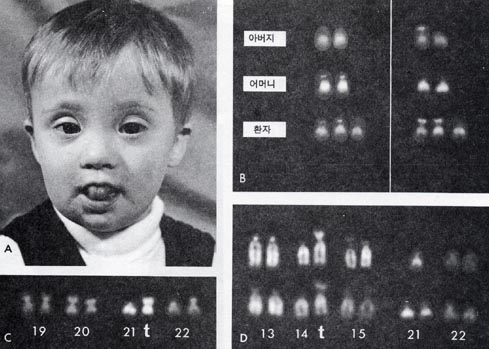
사진 1-224. A: 트라이소미 21을 가진 다운 증후군 남아
B: 2(두) 다운증후군 자녀들과 그들의 부모의 염색체 21
좌: 왼쪽 상염색체 사진 중, 형광이 나타내고 있는 위성세포의 2(두개) 염색체는 엄마로부터 유전된 것이다.
우: 밝게 보이는 위성세포의 2(두개)의 염색체는 아버지의 비분리 세포 분열 두 번째 감수분열에서 생긴 것.
C 21q 21q 전좌
D 14q 21q 엄마 염색체 전좌(상), 그 엄마가 낳은 아이의 염색체 전좌(하)
출처; Reproduced with permission from Nelson Textbook of Pediatrics, W. B. Sounders Company와 소아가정의학백과
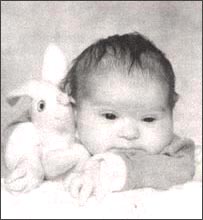
사진 1-225. 다운 증후군을 가진 3개월 된 여 영아
Copyright ⓒ 2011 John Sangwon Lee, MD., FAAP
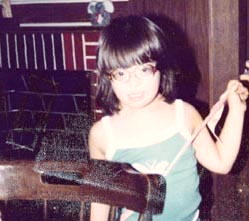
사진 1-226. 다운 증후군을 가진 7세 여아
Copyright ⓒ 2011 John Sangwon Lee, MD, FAAP
- 다운 증후군의 종류에 따라 증상 징후이 다르다.
- 표준형 다운 증후군, 즉 몽고증이 있는 아이의 몸·머리·눈·코·귀·입·손발·체구 등 신체의 모든 계통의 기관과 조직에 이상이 다소 있다.
- 뇌·심장·위장 등 신체 각 계통에도 선천성 기형이 생길 수 있다.
- 신체 여러 계통의 여러 부위에 생긴 선천성 기형은 경미한 것도 있고 치명적인 것도 있다.
- 치명적인 선천성 기형이 있는 다운 증후군 아이들의 대부분은 출생 후 곧 사망한다.
- 다운 증후군 아이들의 지능은 저능한 것이 일반적이고, 여러 종류의 병에 더 잘 걸린다.
- 일단 병에 걸려 앓는 동안 보통 아이들보다 중증도가 더 심할 때가 많다.
- 다운증후군의 증상 징후를 다음 구체적으로 설명하면.
- 다운증후군 아이들 전부가 저능하며 근력이 약하다.
- 납작한 후두개골,
- 안내각 췌피(내안각 주름)가 현저하게 나타난다,
- 브러시 필드반이 홍체에 나타난다.
- 혀를 내민다.
- 저 비교,
- 귀바퀴 기형,
- 선천성 신장기형,
- 소음경,
- 고환정체,
- 얇은 관절구,
- 시미안선,
- 짧고 넓은 손,
- 다섯째 손가락의 중간 지절골 발육부전,
- 엄지발가락과 둘째 발가락 사이가 넓고,
- 높은 입천장,
- 사시,
- 짧은 목,
- 작은 이,
- 갈라진 혀,
- 소장 폐쇄,
- 무공항문증 등이 있을 수 있다.
- 병력·증상 징후·진찰소견을 종합해서 이 병이 의심되면, 염색체 검사로 이 병을 진단한다.
다운 증후군(몽고증)의 치료
- 생명을 위협할 정도 위험한 선천성 기형이 있지 않는 한, 다운 증후군 아이들의 평균 수명은 다운 증후군을 갖지 않은 보통 아이들의 평균 수명과 거의 같다.
- 다운 증후군을 가진 아이들의 거의가 성장 발육해 성인들이 될 때 그들의 지능은 4~5세 유아들의 평균 지능 정도 밖에 안 된다.
- 따라서 부모와 사회국가가 일생 동안 그들의 삶과 안녕을 보살펴 주어야 한다.
- 과거 1970년까지 미국에서 다운 증후군 아이들을 저능아 수용소에 수용했었다.
- 요즘 부모가 집에서 양육하는 것이 보통이고 그들의 능력에 따라 소득 직업도 갖고 산다.
- 다운 증후군 아이들은 대체적으로 순진하고, 욕심이 없고, 남을 해치지 않는 선한 성격을 가진다.
- 그러나 정신지능이 박약해서 일생 동안 유아 지능 수준을 갖고 살아야 하기 때문에 누군가가 일생동안 보살펴 주어야 한다.
- 다운 증후군 자녀를 집에서 양육하는 부모들은 헌신적인 부모들이 되고 만다.
- 다운 증후군 아이들이 감기와 다른 바이러스성 상·하 기도 염·중이염·피부염 등에 더 잘 걸린다. 그런 병에 걸릴 때마다 병의 중증도가 더 심할 수 있다.
- 그래서 대개의 경우 보다 더 적극적으로 치료해야 한다.
- 다운 중후군 아이들의 일부의 지능은 정상 아이들의 낮은 지능 수준과 거의 같다. 그런 아이는 거의 정상적으로 초등학교 교육을 받을 수 있다.
- 대부분의 다운 증후군 아이들은 4~5세 유아들의 발육과 거의 비슷한 정도로 발육되기 때문에 대소변을 가리는 법, 옷을 입고 벗는 법, 세수하는 법 등 일거일동, 일상 생활을 하는 동안 누군가의 감독을 받아야 한다.
- 스스로 자신을 돌볼 수 있는 한도까지 교육시켜서, 부모와 사회, 국가가 가능한 한 그들을 돌봐야 한다.
- 이런 장애아들의 안녕과 그의 가족을 돌보아 줄 수 있는 나라는 그야 말로 문화국이 될 수 있다. 성장 중지증의 내적요인 참조.
Down syndrome (Mongoloid)
Down syndrome normal male chromosome picture

Figure 1-221. normal male chromosomes Chromosomes 1-22 belong to the autosomal and the X Y chromosome (◯) is said to be the sex chromosome that determines the male. Dr. and Professor, Robert Greenstein, University of Conn Medical School. Courtesy

Figure 1-222. normal female chromosomes Chromosomes 1-22 belong to autosomal and X X chromosome (within ◯) is the sex chromosome that determines a woman. Dr. and Professor, Robert Greenstein, Courtesy of University of Conn Medical School

Figure 1-223. Chromosomes in boys with Down syndrome. Instead of having two autosomes on number 22 of autosomes, there are three autosomes, resulting in trisomy 21 syndrome (Down’s syndrome). Courtesy, Dr. and Professor, Robert Greenstein, Courtesy of University of Conn Medical School
Causes of Down Syndrome (Mongoloid)
• If there is an abnormality in the human chromosome, various syndromes occur. The most common of these syndromes is Down syndrome.
• Human chromosomes are divided into two types: autosomal and sex chromosomes. • The total number of chromosomes in a normal person is 46.
• Of 46, 44 are autosomal and 2 are sex chromosomes.
• The number of autosomes or sex chromosomes may be one less or more than the normal number, or the length of the chromosome may be shorter or longer, and the chromosome may be abnormal.
• People with chromosomal abnormalities may experience mental and physical abnormalities, such as intellectual decline, poor growth and development, and physical deformities.
Types of Down Syndrome (Mongoloid)
① Standard Down Syndrome
② Translocation Down Syndrome
③ Mosaic Down Syndrome
④ There is partial Down syndrome.
• Down’s syndrome is also called Mongolian syndrome or 21 trisomy syndrome.
• Among Down syndromes, in Down syndrome, the number of autosomal 21 is one more than the normal number.
• The total number of chromosomes in standard Down syndrome is 47. Since the number of autosomal 21 is one extra, all aspects of a child with standard Down’s syndrome, mentally and physically, are abnormal.
• Hereditary diseases caused by this type of chromosomal abnormality are called standard-type Down syndrome, Mongolian syndrome, autosomal trisomy 21 Down syndrome, or 21 trisomy syndrome.
• 95% of Down’s syndrome is standardized Down’s syndrome.
• In addition to the standard Down Syndrome, there is Translocation Down Syndrome. The total number of chromosomes in translocation-type Down syndrome is equal to the total number of chromosomes in normal people, and translocations between chromosome 21 of group C and number 21 of other groups can occur, and translocation between autosomal 14 and autosomal 21 can occur. This can lead to translocation Down Syndrome. • In other words, the total number of chromosomes in translocation Down syndrome is 46.
Mosaic Down Syndrome
• The total number of chromosomes in mosaic Down syndrome maybe 46 or 47.
• Mosaic Down syndrome accounts for 4% of all Down syndrome.
• The cause of Mosaic Down Syndrome with an extra autosomal is still unknown. • In general, the incidence of Down syndrome is 1 in 600 to 800 newborns.
• The older a pregnant woman is, the more likely she is to have a baby with Down syndrome.
• Women over 35 are more likely to have babies with Down syndrome, especially.
• Down’s syndrome may occur if the fertilized egg undergoes cell division after fertilization and individuation occur.
• Down syndrome can occur due to the dissociation of cells from the father.
• In other cases, Down Syndrome can occur when a fetus becomes infected with a virus, is exposed to radiation, or is hereditary.
• If either parent has an abnormal chromosome that can give birth to a child with Down syndrome, it is possible to have a child with Down syndrome.
• The chromosomes of the parents of a child with Down’s syndrome should be tested to determine which of the two parents has an abnormal chromosome that could give birth to a child with Down’s syndrome.
• There is a chance that the mother of a child with Down syndrome will become pregnant with a child with Down syndrome the next time she becomes pregnant.
• Therefore, it is necessary to draw amniotic fluid during pregnancy and test the fetus’s chromosomes.
Symptoms of Down’s Syndrome (Mongoloid) Signs, Diagnosis

Picture 1-224. A: A boy with Down syndrome with trisomy 21 B: 2 (two) children with Down syndrome and their parent’s chromosome 21 Left: In the left autosomal photo, chromosome 2 (two) of the satellite cells indicated by fluorescence is inherited from the mother. Right: Two (two) chromosomes of brightly visible satellite cells are from the father’s non-separated cell division second meiosis. C 21q 21q translocation
D 14q 21q Chromosomal translocation of the mother (top), chromosomal translocation of the child born of that mother (bottom) source; Reproduced with permission from Nelson Textbook of Pediatrics, W. B. Sounders Company and Encyclopedia of Pediatric and Family Medicine

Picture 1-225. 3-month-old infant girl with Down syndrome Copyright ⓒ 2011 John Sangwon Lee, MD., FAAP

Picture 1-226. 7-year-old girl with Down syndrome Copyright ⓒ 2011 John Sangwon Lee, MD, FAAP • Symptoms and signs vary depending on the type of Down syndrome.
• Standard-type Down syndrome, that is, a child with Mongolian syndrome has some abnormalities in all organs and tissues of the body, including the body, head, eyes, nose, ears, mouth, limbs, and body.
• Congenital malformations can occur in each system of the body, such as the brain, heart, and stomach.
• Congenital anomalies in various parts of the body can be mild or fatal.
• Most children with Down’s syndrome with fatal congenital malformations die soon after birth.
• Children with Down Syndrome are generally less intelligent and more susceptible to various diseases.
• Once they get sick, they are often more severe than normal children during their illness. • Symptoms of Down Syndrome If you describe the symptoms in detail below.
• All children with Down syndrome are retarded and have weak muscles.
• flat epiglottis;
• The guiding angle pancreas (inner canthal fold) is prominently displayed, • Brush field spots appear on the iris.
• Stick out your tongue.
• Low comparison,
• Auricle malformations;
• congenital kidney anomalies; • silencer, • testicular retention; • thin condyles,
• Simian Line,
• Short, broad hands;
• Middle phalangeal hypoplasia of the fifth finger,
• Wide between the big toe and the second toe;
• high palate,
• cross-eye,
• short neck,
• little teeth,
• cleft tongue;
• small intestine obstruction;
• There may be anal atresia.
• If this disease is suspected based on the history, symptoms, signs, and examination findings, the disease is diagnosed with a chromosome test.
Treatment of Down Syndrome (Mongoloid)
• Unless there is a life-threatening congenital anomaly, the life expectancy of children with Down syndrome is approximately the same as that of ordinary children without Down syndrome.
• Nearly all children with Down’s syndrome, when they grow up and become adults, their intelligence is only equal to that of an average 4-5 year old toddler.
• Therefore, parents and the social state should take care of their lives and well-being throughout their lives.
• Until 1970, children with Down syndrome were held in detention centers in the United States.
• It is common for parents to raise children at home these days, and they also have jobs that earn them according to their abilities.
• Children with Down Syndrome are generally naive, ungrateful, and good-natured.
• However, someone has to take care of him for the rest of his life because he is mentally weak and has to live with infant intelligence for the rest of his life.
• Parents who raise children with Down syndrome at home become committed parents.
• Children with Down syndrome are more prone to colds and other viral upper and lower respiratory tract infections, otitis media and dermatitis. With each such illness, the severity of the disease may become more severe.
• Therefore, treatment should be more aggressive than in most cases.
• The intelligence of some of the children with Down syndrome is about the same as the lower intelligence level of normal children. Such a child can receive an almost normal primary school education.
• Most children with Down’s syndrome develop at a level similar to that of infants aged 4-5 years, so they must be supervised during their daily activities, such as how to cover the toilet, how to put on and take off clothes, and how to wash a face. .
• Educate yourself to the extent that you can take care of yourself, so that parents, society and the state take care of them as much as possible.
• A country that can take care of the well-being of these disabled children and their families can truly become a culture bureau. See Intrinsic Factors in Stagnation.
출처와 참조 문헌 Sources and references
- NelsonTextbook of Pediatrics 22ND Ed
- The Harriet Lane Handbook 22ND Ed
- Growth and development of the children
- Red Book 32nd Ed 2021-2024
- Neonatal Resuscitation, American Academy Pediatrics
- www.drleepediatrics.com 제1권 소아청소년 응급 의료
- www.drleepediatrics.com 제2권 소아청소년 예방
- www.drleepediatrics.com 제3권 소아청소년 성장 발육 육아
- www.drleepediatrics.com 제4권 모유,모유수유, 이유
- www.drleepediatrics.com 제5권 인공영양, 우유, 이유식, 비타민, 미네랄, 단백질, 탄수화물, 지방
- www.drleepediatrics.com 제6권 신생아 성장 발육 육아 질병
- www.drleepediatrics.com제7권 소아청소년 감염병
- www.drleepediatrics.com제8권 소아청소년 호흡기 질환
- www.drleepediatrics.com제9권 소아청소년 소화기 질환
- www.drleepediatrics.com제10권. 소아청소년 신장 비뇨 생식기 질환
- www.drleepediatrics.com제11권. 소아청소년 심장 혈관계 질환
- www.drleepediatrics.com제12권. 소아청소년 신경 정신 질환, 행동 수면 문제
- www.drleepediatrics.com제13권. 소아청소년 혈액, 림프, 종양 질환
- www.drleepediatrics.com제14권. 소아청소년 내분비, 유전, 염색체, 대사, 희귀병
- www.drleepediatrics.com제15권. 소아청소년 알레르기, 자가 면역질환
- www.drleepediatrics.com제16권. 소아청소년 정형외과 질환
- www.drleepediatrics.com제17권. 소아청소년 피부 질환
- www.drleepediatrics.com제18권. 소아청소년 이비인후(귀 코 인두 후두) 질환
- www.drleepediatrics.com제19권. 소아청소년 안과 (눈)질환
- www.drleepediatrics.com 제20권 소아청소년 이 (치아)질환
- www.drleepediatrics.com 제21권 소아청소년 가정 학교 간호
- www.drleepediatrics.com 제22권 아들 딸 이렇게 사랑해 키우세요
- www.drleepediatrics.com 제23권 사춘기 아이들의 성장 발육 질병
- www.drleepediatrics.com 제24권 소아청소년 성교육
- www.drleepediatrics.com 제25권 임신, 분만, 출산, 신생아 돌보기
- Red book 29th-31st edition 2021
- Nelson Text Book of Pediatrics 19th- 21st Edition
- The Johns Hopkins Hospital, The Harriet Lane Handbook, 22nd edition
- 응급환자관리 정담미디어
- Pediatric Nutritional Handbook American Academy of Pediatrics
- 소아가정간호백과–부모도 반의사가 되어야 한다, 이상원 저
- The pregnancy Bible. By Joan stone, MD. Keith Eddleman, MD
- Neonatology Jeffrey J. Pomerance, C. Joan Richardson
- Preparation for Birth. Beverly Savage and Dianna Smith
- 임신에서 신생아 돌보기까지. 이상원
- Breastfeeding. by Ruth Lawrence and Robert Lawrence
- Sources and references on Growth, Development, Cares, and Diseases of Newborn Infants
- Emergency Medical Service for Children, By Ross Lab. May 1989. p.10
- Emergency care, Harvey Grant and Robert Murray
- Emergency Care Transportation of Sick and Injured American Academy of Orthopaedic Surgeons
- Emergency Pediatrics A Guide to Ambulatory Care, Roger M. Barkin, Peter Rosen
- Quick Reference To Pediatric Emergencies, Delmer J. Pascoe, M.D., Moses Grossman, M.D. with 26 contributors
- Neonatal resuscitation Ameican academy of pediatrics
- Pediatric Nutritional Handbook American Academy of Pediatrics
- Pediatric Resuscitation Pediatric Clinics of North America, Stephen M. Schexnayder, M.D.
-
Pediatric Critical Care, Pediatric Clinics of North America, James P. Orlowski, M.D.
-
Preparation for Birth. Beverly Savage and Dianna Smith
-
Infectious disease of children, Saul Krugman, Samuel L Katz, Ann A.
- 제4권 모유, 모유수유, 이유 참조문헌 및 출처
- 제5권 인공영양, 우유, 이유, 비타민, 단백질, 지방 탄수 화물 참조문헌 및 출처
- 제6권 신생아 성장발육 양호 질병 참조문헌 및 출처
-
Neurology in Pediatrics, P. F. Bray, Yearbook Medical Publishers
-
Behavior Disorders in Children, Bakwin and Bakwin
- 소아과학 대한교과서
- 의학 용어사전 대한 의사 협회
Copyright ⓒ 2014 John Sangwon Lee, MD., FAAP
“부모도 반의사가 되어야 한다”-내용은 여러분들의 의사로부터 얻은 정보와 진료를 대신할 수 없습니다.
“The information contained in this publication should not be used as a substitute for the medical care and advice of your doctor. There may be variations in treatment that your doctor may recommend based on individual facts and circumstances.
“Parental education is the best medicine.